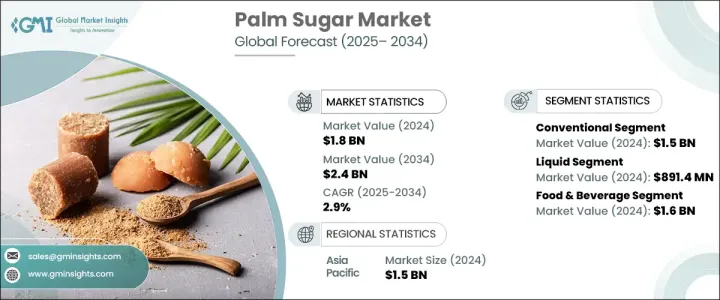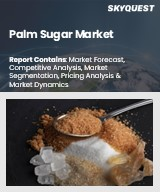
|
시장보고서
상품코드
1716574
팜슈가 시장 : 기회, 성장 촉진요인, 산업 동향 분석 및 예측(2025-2034년)Palm Sugar Market Opportunity, Growth Drivers, Industry Trend Analysis, and Forecast 2025 - 2034 |
||||||
세계의 팜슈가 시장은 2024년에 18억 달러로 평가되었고, 2025년부터 2034년에 걸쳐 2.9%의 연평균 성장률(CAGR)로 성장할 전망입니다.
이러한 성장은 소비자들이 정제 설탕 대신 더 건강한 대안을 찾으면서 건강에 대한 인식이 높아짐에 따라 촉진되고 있습니다. 웰빙과 가공 설탕 섭취 감소에 대한 관심이 높아지면서 혈당 지수가 낮고 칼륨, 아연, 철분과 같은 필수 영양소를 제공하는 팜슈가와 같은 천연 감미료를 찾는 소비자가 늘고 있습니다. 팜슈가의 독특한 캐러멜과 버터스카치 같은 풍미는 요리에 독특한 차원을 더해 식음료 업계에서 널리 채택되고 있습니다. 식물성 및 유기농 식품의 인기가 급증하면서 다양한 제품 제형에 팜슈가이 채택되고 있으며, 시장 수요를 더욱 촉진하고 있습니다. 또한 지속 가능하고 윤리적인 소싱을 지향하는 세계적인 추세에 따라 많은 제조업체들이 환경 친화적인 생산 방식을 강조하고 있어 의식 있는 소비자들 사이에서 팜슈가의 매력은 더욱 커지고 있습니다. 특히 신흥 시장의 가처분 소득 증가도 프리미엄 및 유기농 팜슈가 소비 증가에 기여하고 있습니다.

팜슈가 시장은 크게 일반 설탕과 유기농 설탕으로 나뉘며, 일반 설탕이 가장 많은 점유율을 차지하고 있습니다. 2024년 재래식 팜슈가은 15억 달러 규모를 차지했습니다. 재래식 팜슈가은 야자수에서 수액을 채취한 다음 끓여서 설탕을 만드는 전통적인 기술을 사용하여 생산됩니다. 재래식 품종은 대규모 생산이 가능하기 때문에 소비자와 업계 모두 더 저렴하고 폭넓게 접근할 수 있습니다. 유기농 팜슈가은 건강을 생각하는 소비자들 사이에서 인기를 얻고 있지만, 노동 집약적이고 친환경적인 생산 공정으로 인해 가격이 더 높은 경향이 있습니다. 따라서 유기농 팜슈가은 틈새 시장으로 남아 있으며, 프리미엄 및 특수 시장에서 선호되는 경우가 많습니다.
| 시장 범위 | |
|---|---|
| 시작 연도 | 2024년 |
| 예측 연도 | 2025-2034년 |
| 시작 금액 | 18억 달러 |
| 예측 금액 | 24억 달러 |
| CAGR | 2.9% |
형태별로 분류하면 팜슈가 시장은 분말, 액상, 크리스탈 종류로 나뉩니다. 액상 부문은 2024년에 8억 9,140만 달러를 창출하며 중요한 기여자로 부상했습니다. 액상 팜슈가은 야자수 수액에서 직접 추출하며 천연 성분을 많이 함유하고 있어 가정 요리사와 식품 제조업체 사이에서 인기가 높습니다. 혼합이 쉽고 맛이 일정하기 때문에 소스, 드레싱, 음료, 디저트 등에 사용하기에 이상적입니다. 최소한의 가공을 거친 다용도 감미료에 대한 수요가 증가함에 따라 특히 장인 및 미식가 식품 분야에서 액상 팜슈가의 인기가 높아졌습니다.
아시아태평양 지역은 2024년 15억 달러 규모의 글로벌 팜슈가 시장을 주도할 것으로 예상됩니다. 팜슈가은 수세기 동안 짭짤하고 달콤한 요리에 사용되어 온 많은 아시아 요리에서 문화적, 전통적으로 깊은 의미를 지니고 있습니다. 이 지역의 우호적인 기후와 광범위한 야자수 재배는 탄탄한 공급망을 제공하여 증가하는 소비자 수요를 충족할 수 있는 일관된 생산을 보장합니다. 건강에 대한 의식이 높아지고 소비자들이 천연 감미료를 찾으면서 팜슈가에 대한 수요는 이 지역 전역에서 지속적으로 증가하고 있습니다.
목차
제1장 조사 방법과 조사 범위
제2장 주요 요약
제3장 업계 인사이트
- 생태계 분석
- 밸류체인에 영향을 주는 요인
- 이익률 분석
- 혁신
- 장래의 전망
- 제조업체
- 유통업체
- 공급자의 상황
- 이익률 분석
- 주요 뉴스와 대처
- 규제 상황
- 영향요인
- 성장 촉진요인
- 천연 감미료에 대한 소비자 수요 증가
- 식음료 산업에서의 인기 상승
- 지속가능하고 윤리적인 소비자 선택의 확대
- 업계의 잠재적 위험 및 과제
- 팜슈가 생산에 있어서의 환경 및 사회적 우려
- 성장 촉진요인
- 성장 가능성 분석
- Porter's Five Forces 분석
- PESTEL 분석
제4장 경쟁 구도
- 소개
- 기업 점유율 분석
- 경쟁 포지셔닝 매트릭스
- 전략 전망 매트릭스
제5장 시장 추계 및 예측 : 유형별(2021-2034년)
- 주요 동향
- 기존
- 유기농
제6장 시장 추계 및 예측 : 형태별(2021-2034년)
- 주요 동향
- 분말
- 액상
- 크리스탈
제7장 시장 추계 및 예측 : 최종 용도별(2021-2034년)
- 주요 동향
- 식음료
- 베이커리 및 과자류
- 디저트 및 감미료
- 건강 및 웰빙 제품
- 기타
- 가정용 및 소매
- 호레카
- 화장품 및 퍼스널케어
- 기타
제8장 시장 추계 및 예측 : 지역별(2021-2034년)
- 주요 동향
- 북미
- 미국
- 캐나다
- 유럽
- 독일
- 영국
- 프랑스
- 스페인
- 이탈리아
- 네덜란드
- 아시아태평양
- 중국
- 인도
- 일본
- 호주
- 한국
- 라틴아메리카
- 브라질
- 멕시코
- 아르헨티나
- 중동 및 아프리카
- 사우디아라비아
- 남아프리카
- 아랍에미리트(UAE)
제9장 기업 프로파일
- Agro-Productos del Tropico
- Cocoasia Philippines
- Cocowell Farm
- El Guapo
- Farm Organic
- JaggeryWorks
- La Blanquita
- La Palma Organics
- Mitr Phol Sugar Corporation
- Palm Organix
The Global Palm Sugar Market, valued at USD 1.8 billion in 2024, is poised to grow at a steady CAGR of 2.9% from 2025 to 2034. This growth is fueled by rising health awareness as consumers seek healthier alternatives to refined sugars. With an increasing focus on wellness and the reduction of processed sugar intake, more consumers are gravitating towards natural sweeteners like palm sugar, which offers a lower glycemic index and essential nutrients such as potassium, zinc, and iron. Palm sugar's distinct caramel and butterscotch-like flavor adds a unique dimension to culinary applications, driving its widespread adoption in the food and beverage industry. As the popularity of plant-based and organic food products surges, palm sugar is being embraced in various product formulations, further propelling market demand. Additionally, with the global shift towards sustainable and ethical sourcing, many manufacturers are emphasizing environmentally friendly production methods, adding to the appeal of palm sugar among conscious consumers. Increasing disposable incomes, especially in emerging markets, are also contributing to the rise in premium and organic palm sugar consumption.

The palm sugar market is primarily segmented into conventional and organic types, with the conventional segment commanding the majority share. In 2024, conventional palm sugar accounted for USD 1.5 billion. It is produced using traditional techniques that involve tapping sap from palm trees, which is then boiled to create sugar. The conventional variety allows for large-scale production, making it more affordable and widely accessible to both consumers and industries. Organic palm sugar, while gaining traction among health-conscious consumers, tends to be priced higher due to its more labor-intensive and eco-friendly production process. As a result, organic palm sugar remains a niche segment, often preferred in premium and specialty markets.
| Market Scope | |
|---|---|
| Start Year | 2024 |
| Forecast Year | 2025-2034 |
| Start Value | $1.8 Billion |
| Forecast Value | $2.4 Billion |
| CAGR | 2.9% |
When categorized by form, the palm sugar market is divided into powder, liquid, and crystal varieties. The liquid segment emerged as a significant contributor, generating USD 891.4 million in 2024. Liquid palm sugar is extracted directly from the sap of palm trees and retains much of its natural composition, making it a popular choice among home cooks and food manufacturers. Its ease of mixing and consistent flavor make it ideal for use in sauces, dressings, beverages, and desserts. The rising demand for minimally processed and versatile sweeteners has increased the popularity of liquid palm sugar, particularly in artisanal and gourmet food applications.
Asia Pacific dominates the global palm sugar market, generating USD 1.5 billion in 2024. Palm sugar holds deep cultural and traditional significance in many Asian cuisines, where it has been used for centuries in both savory and sweet dishes. The region's favorable climate and widespread cultivation of palm trees provide a robust supply chain, ensuring consistent production to meet rising consumer demand. As health consciousness rises and consumers seek out natural sweeteners, the demand for palm sugar continues to strengthen across the region. Furthermore, growing export opportunities and increasing use in international cuisines have solidified Asia Pacific's position as a key market driver for palm sugar on a global scale.
Table of Contents
Chapter 1 Methodology and Scope
- 1.1 Market scope and definition
- 1.2 Base estimates and calculations
- 1.3 Forecast calculation
- 1.4 Data sources
- 1.4.1 Primary
- 1.4.2 Secondary
- 1.4.2.1 Paid sources
- 1.4.2.2 Public sources
- 1.5 Primary research and validation
- 1.5.1 Primary sources
- 1.5.2 Data mining sources
Chapter 2 Executive Summary
- 2.1 Industry synopsis, 2021-2034
Chapter 3 Industry Insights
- 3.1 Industry ecosystem analysis
- 3.1.1 Factor affecting the value chain
- 3.1.2 Profit margin analysis
- 3.1.3 Disruptions
- 3.1.4 Future outlook
- 3.1.5 Manufacturers
- 3.1.6 Distributors
- 3.2 Supplier landscape
- 3.3 Profit margin analysis
- 3.4 Key news and initiatives
- 3.5 Regulatory landscape
- 3.6 Impact forces
- 3.6.1 Growth drivers
- 3.6.1.1 Increasing consumer demand for natural sweeteners
- 3.6.1.2 Rising popularity in the food and beverage industry
- 3.6.1.3 Expanding sustainable and ethical consumer choices
- 3.6.2 Industry pitfalls and challenges
- 3.6.2.1 Environmental and social concerns in palm sugar production
- 3.6.1 Growth drivers
- 3.7 Growth potential analysis
- 3.8 Porter's analysis
- 3.9 PESTEL analysis
Chapter 4 Competitive Landscape, 2024
- 4.1 Introduction
- 4.2 Company market share analysis
- 4.3 Competitive positioning matrix
- 4.4 Strategic outlook matrix
Chapter 5 Market Estimates and Forecast, By Type, 2021 - 2034 (USD Billion) (Kilo Tons)
- 5.1 Key trends
- 5.2 Conventional
- 5.3 Organic
Chapter 6 Market Estimates and Forecast, By Form, 2021 - 2034 (USD Billion) (Kilo Tons)
- 6.1 Key trends
- 6.2 Powder
- 6.3 Liquid
- 6.4 Crystal
Chapter 7 Market Estimates and Forecast, By End Use, 2021 - 2034 (USD Billion) (Kilo Tons)
- 7.1 Key trends
- 7.2 Food & beverages
- 7.2.1 Bakery & confectionery
- 7.2.2 Desserts & sweeteners
- 7.2.3 Health & wellness products
- 7.2.4 Others
- 7.3 Household/retail
- 7.4 Horeca
- 7.5 Cosmetics & personal care
- 7.6 Others
Chapter 8 Market Estimates and Forecast, By Region, 2021 - 2034 (USD Billion) (Kilo Tons)
- 8.1 Key trends
- 8.2 North America
- 8.2.1 U.S.
- 8.2.2 Canada
- 8.3 Europe
- 8.3.1 Germany
- 8.3.2 UK
- 8.3.3 France
- 8.3.4 Spain
- 8.3.5 Italy
- 8.3.6 Netherlands
- 8.4 Asia Pacific
- 8.4.1 China
- 8.4.2 India
- 8.4.3 Japan
- 8.4.4 Australia
- 8.4.5 South Korea
- 8.5 Latin America
- 8.5.1 Brazil
- 8.5.2 Mexico
- 8.5.3 Argentina
- 8.6 Middle East and Africa
- 8.6.1 Saudi Arabia
- 8.6.2 South Africa
- 8.6.3 UAE
Chapter 9 Company Profiles
- 9.1 Agro-Productos del Tropico
- 9.2 Cocoasia Philippines
- 9.3 Cocowell Farm
- 9.4 El Guapo
- 9.5 Farm Organic
- 9.6 JaggeryWorks
- 9.7 La Blanquita
- 9.8 La Palma Organics
- 9.9 Mitr Phol Sugar Corporation
- 9.10 Palm Organix












